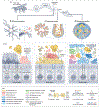The honeybee microbiota and its impact on health and disease
- PMID: 38049554
- PMCID: PMC10998682
- DOI: 10.1038/s41579-023-00990-3
The honeybee microbiota and its impact on health and disease
Abstract
Honeybees (Apis mellifera) are key pollinators that support global agriculture and are long-established models for developmental and behavioural research. Recently, they have emerged as models for studying gut microbial communities. Earlier research established that hindguts of adult worker bees harbour a conserved set of host-restricted bacterial species, each showing extensive strain variation. These bacteria can be cultured axenically and introduced to gnotobiotic hosts, and some have basic genetic tools available. In this Review, we explore the most recent research showing how the microbiota establishes itself in the gut and impacts bee biology and health. Microbiota members occupy specific niches within the gut where they interact with each other and the host. They engage in cross-feeding and antagonistic interactions, which likely contribute to the stability of the community and prevent pathogen invasion. An intact gut microbiota provides protection against diverse pathogens and parasites and contributes to the processing of refractory components of the pollen coat and dietary toxins. Absence or disruption of the microbiota results in altered expression of genes that underlie immunity, metabolism, behaviour and development. In the field, such disruption by agrochemicals may negatively impact bees. These findings demonstrate a key developmental and protective role of the microbiota, with broad implications for bee health.
© 2023. Springer Nature Limited.
Conflict of interest statement
Competing interests
N.A.M. is an author on a patent application (US20220152128A1) for using native bee gut bacteria as bee probiotics. E.V.S.M. declares no competing interests.
Figures





References
-
- Robinson GE, Page RE Jr, Strambi C & Strambi A Hormonal and genetic control of behavioral integration in honey bee colonies. Science 246, 109–112 (1989). - PubMed
-
- Menzel R. The honeybee as a model for understanding the basis of cognition. Nat. Rev. Neurosci 13, 758–768 (2012). - PubMed
-
- Zayed A & Robinson GE Understanding the relationship between brain gene expression and social behavior: lessons from the honey bee. Annu. Rev. Genet 46, 591–615 (2012). - PubMed
-
- Romero S, Nastasa A, Chapman A, Kwong WK & Foster LJ The honey bee gut microbiota: strategies for study and characterization. Insect Mol. Biol 28, 455–472 (2019). - PubMed
Publication types
MeSH terms
Grants and funding
LinkOut - more resources
Full Text Sources
Medical

